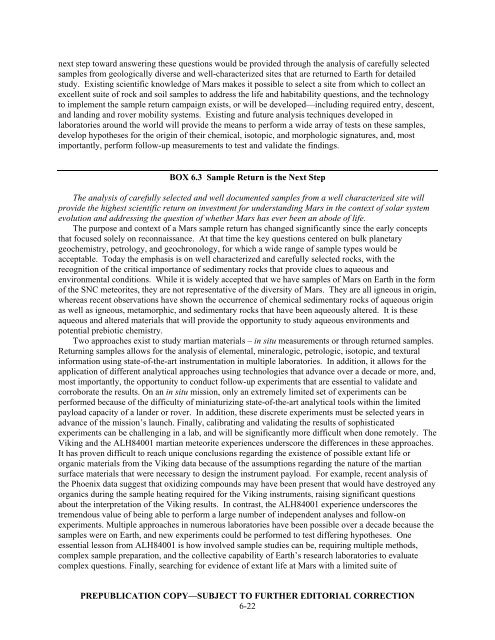Vision and Voyages for Planetary Science in the - Solar System ...
Vision and Voyages for Planetary Science in the - Solar System ...
Vision and Voyages for Planetary Science in the - Solar System ...
Create successful ePaper yourself
Turn your PDF publications into a flip-book with our unique Google optimized e-Paper software.
next step toward answer<strong>in</strong>g <strong>the</strong>se questions would be provided through <strong>the</strong> analysis of carefully selected<br />
samples from geologically diverse <strong>and</strong> well-characterized sites that are returned to Earth <strong>for</strong> detailed<br />
study. Exist<strong>in</strong>g scientific knowledge of Mars makes it possible to select a site from which to collect an<br />
excellent suite of rock <strong>and</strong> soil samples to address <strong>the</strong> life <strong>and</strong> habitability questions, <strong>and</strong> <strong>the</strong> technology<br />
to implement <strong>the</strong> sample return campaign exists, or will be developed—<strong>in</strong>clud<strong>in</strong>g required entry, descent,<br />
<strong>and</strong> l<strong>and</strong><strong>in</strong>g <strong>and</strong> rover mobility systems. Exist<strong>in</strong>g <strong>and</strong> future analysis techniques developed <strong>in</strong><br />
laboratories around <strong>the</strong> world will provide <strong>the</strong> means to per<strong>for</strong>m a wide array of tests on <strong>the</strong>se samples,<br />
develop hypo<strong>the</strong>ses <strong>for</strong> <strong>the</strong> orig<strong>in</strong> of <strong>the</strong>ir chemical, isotopic, <strong>and</strong> morphologic signatures, <strong>and</strong>, most<br />
importantly, per<strong>for</strong>m follow-up measurements to test <strong>and</strong> validate <strong>the</strong> f<strong>in</strong>d<strong>in</strong>gs.<br />
BOX 6.3 Sample Return is <strong>the</strong> Next Step<br />
The analysis of carefully selected <strong>and</strong> well documented samples from a well characterized site will<br />
provide <strong>the</strong> highest scientific return on <strong>in</strong>vestment <strong>for</strong> underst<strong>and</strong><strong>in</strong>g Mars <strong>in</strong> <strong>the</strong> context of solar system<br />
evolution <strong>and</strong> address<strong>in</strong>g <strong>the</strong> question of whe<strong>the</strong>r Mars has ever been an abode of life.<br />
The purpose <strong>and</strong> context of a Mars sample return has changed significantly s<strong>in</strong>ce <strong>the</strong> early concepts<br />
that focused solely on reconnaissance. At that time <strong>the</strong> key questions centered on bulk planetary<br />
geochemistry, petrology, <strong>and</strong> geochronology, <strong>for</strong> which a wide range of sample types would be<br />
acceptable. Today <strong>the</strong> emphasis is on well characterized <strong>and</strong> carefully selected rocks, with <strong>the</strong><br />
recognition of <strong>the</strong> critical importance of sedimentary rocks that provide clues to aqueous <strong>and</strong><br />
environmental conditions. While it is widely accepted that we have samples of Mars on Earth <strong>in</strong> <strong>the</strong> <strong>for</strong>m<br />
of <strong>the</strong> SNC meteorites, <strong>the</strong>y are not representative of <strong>the</strong> diversity of Mars. They are all igneous <strong>in</strong> orig<strong>in</strong>,<br />
whereas recent observations have shown <strong>the</strong> occurrence of chemical sedimentary rocks of aqueous orig<strong>in</strong><br />
as well as igneous, metamorphic, <strong>and</strong> sedimentary rocks that have been aqueously altered. It is <strong>the</strong>se<br />
aqueous <strong>and</strong> altered materials that will provide <strong>the</strong> opportunity to study aqueous environments <strong>and</strong><br />
potential prebiotic chemistry.<br />
Two approaches exist to study martian materials – <strong>in</strong> situ measurements or through returned samples.<br />
Return<strong>in</strong>g samples allows <strong>for</strong> <strong>the</strong> analysis of elemental, m<strong>in</strong>eralogic, petrologic, isotopic, <strong>and</strong> textural<br />
<strong>in</strong><strong>for</strong>mation us<strong>in</strong>g state-of-<strong>the</strong>-art <strong>in</strong>strumentation <strong>in</strong> multiple laboratories. In addition, it allows <strong>for</strong> <strong>the</strong><br />
application of different analytical approaches us<strong>in</strong>g technologies that advance over a decade or more, <strong>and</strong>,<br />
most importantly, <strong>the</strong> opportunity to conduct follow-up experiments that are essential to validate <strong>and</strong><br />
corroborate <strong>the</strong> results. On an <strong>in</strong> situ mission, only an extremely limited set of experiments can be<br />
per<strong>for</strong>med because of <strong>the</strong> difficulty of m<strong>in</strong>iaturiz<strong>in</strong>g state-of-<strong>the</strong>-art analytical tools with<strong>in</strong> <strong>the</strong> limited<br />
payload capacity of a l<strong>and</strong>er or rover. In addition, <strong>the</strong>se discrete experiments must be selected years <strong>in</strong><br />
advance of <strong>the</strong> mission’s launch. F<strong>in</strong>ally, calibrat<strong>in</strong>g <strong>and</strong> validat<strong>in</strong>g <strong>the</strong> results of sophisticated<br />
experiments can be challeng<strong>in</strong>g <strong>in</strong> a lab, <strong>and</strong> will be significantly more difficult when done remotely. The<br />
Vik<strong>in</strong>g <strong>and</strong> <strong>the</strong> ALH84001 martian meteorite experiences underscore <strong>the</strong> differences <strong>in</strong> <strong>the</strong>se approaches.<br />
It has proven difficult to reach unique conclusions regard<strong>in</strong>g <strong>the</strong> existence of possible extant life or<br />
organic materials from <strong>the</strong> Vik<strong>in</strong>g data because of <strong>the</strong> assumptions regard<strong>in</strong>g <strong>the</strong> nature of <strong>the</strong> martian<br />
surface materials that were necessary to design <strong>the</strong> <strong>in</strong>strument payload. For example, recent analysis of<br />
<strong>the</strong> Phoenix data suggest that oxidiz<strong>in</strong>g compounds may have been present that would have destroyed any<br />
organics dur<strong>in</strong>g <strong>the</strong> sample heat<strong>in</strong>g required <strong>for</strong> <strong>the</strong> Vik<strong>in</strong>g <strong>in</strong>struments, rais<strong>in</strong>g significant questions<br />
about <strong>the</strong> <strong>in</strong>terpretation of <strong>the</strong> Vik<strong>in</strong>g results. In contrast, <strong>the</strong> ALH84001 experience underscores <strong>the</strong><br />
tremendous value of be<strong>in</strong>g able to per<strong>for</strong>m a large number of <strong>in</strong>dependent analyses <strong>and</strong> follow-on<br />
experiments. Multiple approaches <strong>in</strong> numerous laboratories have been possible over a decade because <strong>the</strong><br />
samples were on Earth, <strong>and</strong> new experiments could be per<strong>for</strong>med to test differ<strong>in</strong>g hypo<strong>the</strong>ses. One<br />
essential lesson from ALH84001 is how <strong>in</strong>volved sample studies can be, requir<strong>in</strong>g multiple methods,<br />
complex sample preparation, <strong>and</strong> <strong>the</strong> collective capability of Earth’s research laboratories to evaluate<br />
complex questions. F<strong>in</strong>ally, search<strong>in</strong>g <strong>for</strong> evidence of extant life at Mars with a limited suite of<br />
PREPUBLICATION COPY—SUBJECT TO FURTHER EDITORIAL CORRECTION<br />
6-22











